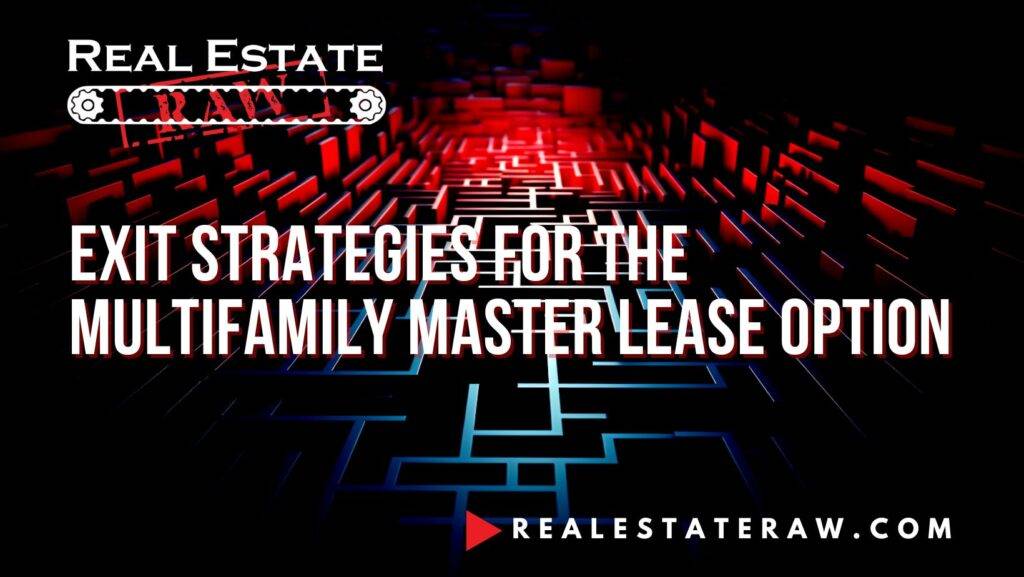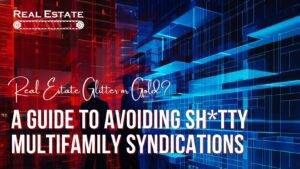There is one thing you must always remember about real estate- If you cannot execute a successful exit strategy, you will find yourself in trouble.
A successful exit strategy should be created long before you sign on the dotted line. If you cannot conceive of several reasonable exit strategies in your deal analysis, then you may not be looking at a good deal. Let’s look at some exit strategies specific to master lease options for multifamily deals.
Sell the Lease
In this case, you will just sell the lease but retain the option rights separately. The purchase of the lease will purchase the rights stated in your lease, such as the profits above the lease payments. People will purchase the lease to buy the income stream. If this is an exit strategy you plan to use, try to get the longest lease term possible. This will increase the salability of the lease.
Surrender the Master Lease Option
In short, this means that during the master lease option term, you decide the property is not worth buying and you walk away from the deal and forfeit the option money. This would be a worst-case scenario, but if you realize that the deal is not going to hold its value, it may be smarter to lose the option money, or whatever portion you have not yet earned back in cash flow, than to close on a bad deal that may continue to lose money.
Close the Option
In this exit strategy, you exercise your option to purchase and close the deal. If you have cash on hand to purchase the property, then you will simply close with an attorney and take possession of the property like a regular sale. If you don’t have the cash at closing, then you can refinance the deal.
Refinance
Refinancing is not an optional exit for a multifamily master lease option deal. You are a renter not an owner. You cannot refinance something you don’t own. When you exercise your option to purchase, the lender will consider it a new purchase. Typically, the lender will lend on the appraisal for the asset or the purchase price (option price in the master lease option), whichever is lower.
You are likely to be given experiential credit for having operated the asset during your hold time, but this will not likely affect the loan amount. You should be prepared to bring an applicable amount of down payment money to the deal if you plan to exercise the options by using traditional debt.
Give Someone Else a Master Lease Option
Some people have properties they wish they didn’t have. I started my real estate career buying houses. I still have some of those houses today, and I wish I did not. If you ever find yourself in this situation, you can give someone else a master lease option. You can reverse all the things I have taught you in this book and be on the other side of the equation.
If you have a property that is not currently making money—maybe you don’t want to manage it, or it needs fixing up to be rentable again—a master lease option could be your solution. All you need to do is recruit a buyer for your deal. Since you are the one with the creative financing education, you may need to educate your buyer. You will want to be careful and screen your buyer the way you would screen a seller. Find someone with the time and energy to get your distressed assets back into good shape. Here are a few things I suggest:
- Be willing to give an amount of free rent to equal the repair costs. If the rent is $500 a month with $2000 in repairs, give the buyer four months of free rent to get the repairs done. Then they should be making you payments.
- Make the buyer use their option money to do repairs. Make them put it into an escrow account where you can see it.
- Don’t give a master lease for longer than your loan term.
- Make the monthly payment equal to your mortgage payment, plus a percentage of the profits.
- Have the buyer escrow for taxes, insurance, and mortgage payment.
In the summer of 2016, I used this “exit strategy” with a four-unit property I had in a marginal neighborhood. It became difficult to collect rent there, and the tenants became difficult to deal with. The rents in this building were low, and the conclusion I came to was that I was losing money spending my time dealing with this property. A better use of my time would be to focus on managing the several hundred units that do make lots of money or getting another property that cash flowed a few hundred bucks a month. The decision to “exit” became a no-brainer!
Once I realized the opportunity cost of dealing with this quad, I decided to give a master lease option to a local church. They had no idea how a master lease worked, so I explained it. They were more than eager to take control of the property for me. I gave them several months of free rent in exchange for doing the repairs. Their payment to me covered the mortgage, taxes, and insurance amounts. I let them have the property at break-even. It no longer makes me any profit, but it breaks even, I keep the tax benefits of ownership, and I can make my money running other more profitable properties.
The church loves it. They don’t care about making it cash flow because they use the units for a battered women’s program. We all won!
Use the master lease option exit strategy to solve your distressed asset problems. You could start with churches, nonprofits, and new investors. Give someone a break in the business, and get your headaches solved too!
For more information on using multifamily master lease options check out my site www.realestateraw.com.
Best of luck!
Bill Ham


































